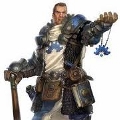| Author |
Message |
 |
|
|
 |
|
Advert
|
Forum adverts like this one are shown to any user who is not logged in. Join us by filling out a tiny 3 field form and you will get your own, free, dakka user account which gives a good range of benefits to you:
- No adverts like this in the forums anymore.
- Times and dates in your local timezone.
- Full tracking of what you have read so you can skip to your first unread post, easily see what has changed since you last logged in, and easily see what is new at a glance.
- Email notifications for threads you want to watch closely.
- Being a part of the oldest wargaming community on the net.
If you are already a member then feel free to login now. |
|
 |
![[Post New]](/s/i/i.gif) 2019/07/06 18:09:42
Subject: Model tips - the flick test
|
 |

Decrepit Dakkanaut
UK
|
So this is something I don't oft if ever see mentioned and thought it would be worth a word to help out others.
This is a method use when working with superglue bonds, so typically working with resins and metals or any plastic to resin/metal bond. Plastic on plastic one would typically use a plastic cement glue which works differently to superglues and shouldn't need any flick test being performed.
The flick test is simple, first assemble the model in full or in part (depending on its complexity and if you want to part paint it or not) and then wait for the glue to fully cure. This can take a while as glue goes through several curing stages before its fully hard. It will vary glue to glue but hours are not out of the question. The key is that you don't want to perform the test too early or else it will likely fail.
So once you've got the bond fully set and cured you simply take hold of one half of the model in one hand and the with the other hand flick your finger at the model. I typically use the nail of my middle finger to strike the model.
This is a firm flick but not a super hard one. The idea is to basically test he bond and see if it can hold up to a bit of a jolt/bump/impact. I will typically do a few flicks, starting with very little pressure and building up. This way if it is a very weak bond I'm not sending parts sailing all over the place. It also means you can gauge your strength accordingly. Again you're testing the bond against a light bump not trying to tear it apart.
If the join fails simply clean the join surfaces to ensure that there's no (or very little )glue residue and then apply fresh glue and join. Sometimes you might identify pionts that seem to never seal up. For those first make certain the old glue is cleaned away - scraping with a blade when the glue is dry works well. Then score the join surfaces. If the bond keeps failing then consider pinning/bone pinning to add strength to the join.
For me this is something I test on most models I assemble with superglue, but I'd especially test any points that hold up the model or otherwise have a large amount of weight on them. Something like spies or bayonets I might not est, but leg and arm joins are an almost must as they are far more likely to be bumped/jolted or take the hit from a drop.
This doesn't guarantee that the bond is cast iron, just that the model is able to hold up to general wear and tear.
|
|
|
|
 |
 |
![[Post New]](/s/i/i.gif) 2019/07/08 18:33:14
Subject: Model tips - the flick test
|
 |

Regular Dakkanaut
|
I usually do this test by accidentally dropping the damn thing.
|
|
|
 |
 |
![[Post New]](/s/i/i.gif) 2019/07/09 09:17:40
Subject: Model tips - the flick test
|
 |

Liche Priest Hierophant
|
That's my favorite method, too.
|
Nehekhara lives! Sort of!
Why is the rum always gone? |
|
|
 |
 |
![[Post New]](/s/i/i.gif) 2019/07/09 09:24:06
Subject: Model tips - the flick test
|
 |

[DCM]
Procrastinator extraordinaire
|
I tend to find out when I'm transporting my models and go for some on the fly gluing to fix them up.
|
|
|
|
 |
 |
![[Post New]](/s/i/i.gif) 2019/07/12 11:04:32
Subject: Model tips - the flick test
|
 |

Decrepit Dakkanaut
UK
|
See that's why I try to avoid with this, by doing it as an actual test rather than relying on random chance bumps I tend to avoid small knocks breaking parts off models. Plus it means there's no paint or greenstuff fixing which has gone on so if a part falls off its much easier to repair and, if needed, modify with metal rods etc...
|
|
|
|
 |
 |
![[Post New]](/s/i/i.gif) 2019/07/12 11:51:34
Subject: Model tips - the flick test
|
 |

Blood Angel Terminator with Lightning Claws
|
Sometimes when gluing an arm to a torso say, the arm will sag and fall off.
I find that leaving the glue that is on the 2 mating surfaces already providing you haven't used too much bonds better with a second application, sort of like impact adhesive you leave to go tacky before pressing together
|
 DV8 wrote: DV8 wrote:Blood Angels Furioso Dreadnought should also be double-fisted.
|
|
|
 |
 |
![[Post New]](/s/i/i.gif) 2019/07/12 12:48:18
Subject: Model tips - the flick test
|
 |

Rogue Grot Kannon Gunna
|
You can also sprinkle a little bit of baking powder over the two joints and a drop of superglue. The two react filling up any cracks and also forming a strong bond.
This is a magic for metal miniatures of olde.
|
 Russian Rebel Grots : 6,500 points painted P: 8 W: 2 D: 5 L: 1 Russian Rebel Grots : 6,500 points painted P: 8 W: 2 D: 5 L: 1
 Death Guard 1.0: 8,500 points painted (Pics available in Gallery) P: 7 W: 1 D: 3 L: 3 Death Guard 1.0: 8,500 points painted (Pics available in Gallery) P: 7 W: 1 D: 3 L: 3
 Death Guard 2.0 "Plaguepigs": 4,250 points painted P:4 W:3 D:0 L: 1 Death Guard 2.0 "Plaguepigs": 4,250 points painted P:4 W:3 D:0 L: 1
 Thousand Sons: 3,750 points painted P:1 W:1 D:0 L:0 Thousand Sons: 3,750 points painted P:1 W:1 D:0 L:0
 Nurgle Daemons: 3,800 points painted P:2 W:1 D:1 L:0 Nurgle Daemons: 3,800 points painted P:2 W:1 D:1 L:0
 Tyranids: 2,000 points painted Tyranids: 2,000 points painted
 Primaris "Honoured Mastodons": 3,700 points painted Primaris "Honoured Mastodons": 3,700 points painted
 Tallarn Desert Raiders 2,000 points painted Tallarn Desert Raiders 2,000 points painted  Tau 6,750 points painted Tau 6,750 points painted |
|
|
 |
 |
![[Post New]](/s/i/i.gif) 2019/07/13 14:57:42
Subject: Model tips - the flick test
|
 |

Fixture of Dakka
West Michigan, deep in Whitebread, USA
|
I determine if the bond is strong if the mini stays together as use enough force to I tear it off the finger it glued itself to.
|
       
"By this point I'm convinced 100% that every single race in the 40k universe have somehow tapped into the ork ability to just have their tech work because they think it should." |
|
|
 |
 |
![[Post New]](/s/i/i.gif) 2019/07/13 15:26:45
Subject: Model tips - the flick test
|
 |

Junior Officer with Laspistol
|
I usually place a mini on the ground and run over it with a car.
Disappointingly, I have yet to find an adhesive strong enough for my pointless destructive testing, but I remain hopeful. 
|
|
|
 |
 |
![[Post New]](/s/i/i.gif) 2019/07/13 16:06:42
Subject: Model tips - the flick test
|
 |

Regular Dakkanaut
|
too many end up with Tikay Fortooum's method or worse, AegisGrimms
|
|
|
 |
 |
![[Post New]](/s/i/i.gif) 2019/07/14 00:46:48
Subject: Re:Model tips - the flick test
|
 |

Longtime Dakkanaut
|
I feel better about myself reading this thread, as I have tried all these methods many times...
@Low K: That's a new tip for me. Will have to try it. Thanks.
|
Keeping the hobby side alive!
I never forget the Dakka unit scale is binary: Units are either OP or Garbage. |
|
|
 |
 |
![[Post New]](/s/i/i.gif) 2019/07/14 00:55:15
Subject: Model tips - the flick test
|
 |

Decrepit Dakkanaut
UK
|
 AegisGrimm wrote: AegisGrimm wrote:
I determine if the bond is strong if the mini stays together as use enough force to I tear it off the finger it glued itself to.
I find this method tends to rear its head for me whenever the parts are particularly spiky and hard to hold and made of metal. Pain of body and pain of mind all mixed together when you finally get to let your fingers stop suffering with the pain only to see the parts come away
|
|
|
|
 |
 |
|
|